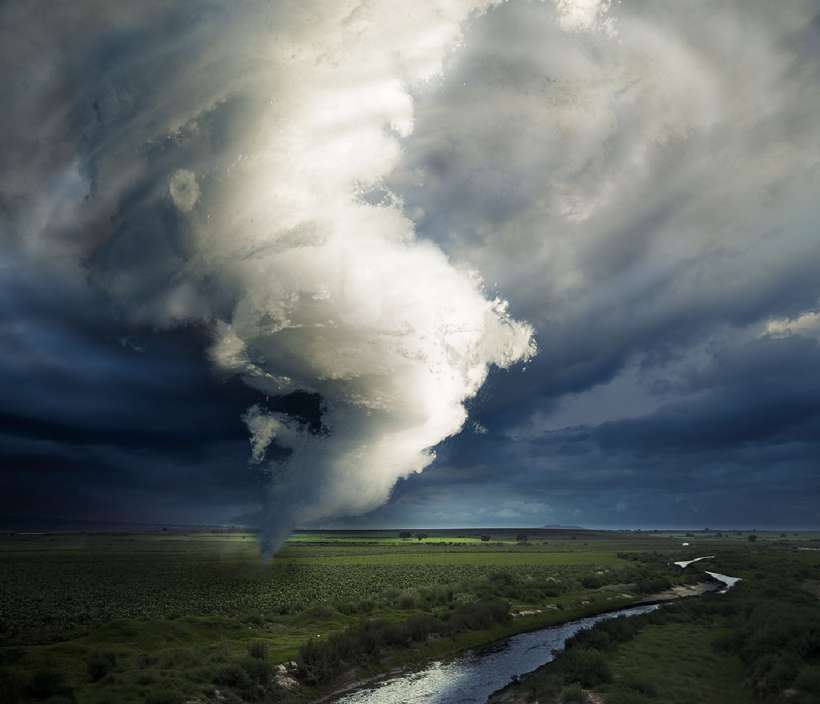If you ever happen to see a dark often greenish sky, wall cloud, large hail and a loud roar similar to a freight train then run to a safe place as it could be a tornado.
Popularly known as twisters, tornado is derived from Spanish word ‘Tronada’ meaning thunderstorm and ‘Tornar’ meaning to turn.
![Tornadoes [Illustrations by Amarjeet Malik]](/media/earth-20_1_hu9601aac44bcd901ceefa95b6a7df9fb8_19545_820x0_resize_q60_box.jpg)
A tornado is defined as a violently rotating column of air that can spin faster than 300 m.p.h., extending from a thunderstorm to the ground. They are generally observed as tube-or funnel-shaped clouds. At ground level they usually leave a path of destruction about 50 m wide and travel an average of about 8 to 24 km.
Tornadoes generally exhibit a certain characteristic cycle of behaviour between formation and final disappearance. The first sign of a tornado may be a strong whirlwind of dust from the ground surface, often in conjunction with the appearance of a short funnel growing from the storm cloud above it. The funnel then becomes more organised and descends further from the cloud, sometimes touching the ground. The funnel as a whole moves forward slowly but can travel at speeds greater than 30 meters per second. The tornado eventually becomes fragmented and dissipates.

Tornadoes occasionally accompany tropical storms and hurricanes that move over land. They are the result of great instability in the atmosphere and are often associated with severe thunderstorms. The full details of the formation of tornadoes are not known. Before thunderstorms develop, a change in wind direction and an increase in wind speed with increasing height creates an invisible horizontal spinning effect in the lower atmosphere. Rising air within the thunderstorm updraft tilts the rotating air from horizontal to vertical.
An area of rotation, 2-6 miles wide, now extends through much of the storm. Most strong and violent tornadoes form within this area of strong rotation. Softball size hail and damaging winds also occur with this storm.
Tornadoes take many shapes and sizes. Weak tornadoes form 69% of all tornadoes and cause less than 5% of tornado deaths. The lifetime is 1 to 10 minutes and wind speed is less than 110mph. Strong tornadoes form 29% of all tornadoes and cause nearly 30% of all tornado deaths. They may last 20 minutes or longer and wind speed is between 110 to 205 mph.
It is commonly believed that areas near rivers, lakes and mountains are safe from tornadoes. No place is safe. In fact in the late 1980’s a tornado swept through Yellowstone national park in the US leaving a path of destruction up and down a 10,000 ft mountain. It is also believed that windows should be opened before a tornado approaches to equalise pressure and minimise damage. However opening of windows only allows damaging winds to enter the structure. Leave the windows alone instead go to a safe place.
Trivia about tornadoes
Although tornadoes form all over the world, they are more frequent and stronger in US.
A tornado that forms over warm water is called a waterspout. The water in the spout comes from condensation, not from the water below.
When it forms over a desert, it’s called a dustdevil.
Neither are strong tornadoes.
The average forward speed of a tornado is 30 to 40 mph but can go as fast as 70mph and has rotational speed that can be more than 300mph.
Tornadoes can occur in series (one after another) and more than one can form from the same cloud system.
The worst series of tornadoes in history was on March 18, 1925. About 689 people were killed in Missouri, Illinois and Indiana.
Usually in the northern atmosphere (above the equator) tornadoes turn counter-clockwise (left).In the southern hemisphere, tornadoes usually turn clockwise.
Tornadoes can be invisible!!! They appear nearly transparent until dust and debris are picked up.
Tornadoes can be over a mile-wide or really skinny.
Tornadoes occur mostly in May. They occur the least in the months of January and February. Tornadoes occur most frequently during the middle and late afternoon.
Scientists can’t rate or know how strong a tornado is until after it is over.
707 words |
7 minutes
Readability:
Grade 8 (13-14 year old children)
Based on Flesch–Kincaid readability scores
Filed under: 5ws and h
Tags: #storms, #clouds, #atmosphere, #tornado
You may also be interested in these:
Robbing the Rich for Rain
The Dark Kingdom of Uranus
The Red Flower
Trees are afraid of storms and not the grass on the ground.
Why Do Stars Twinkle?